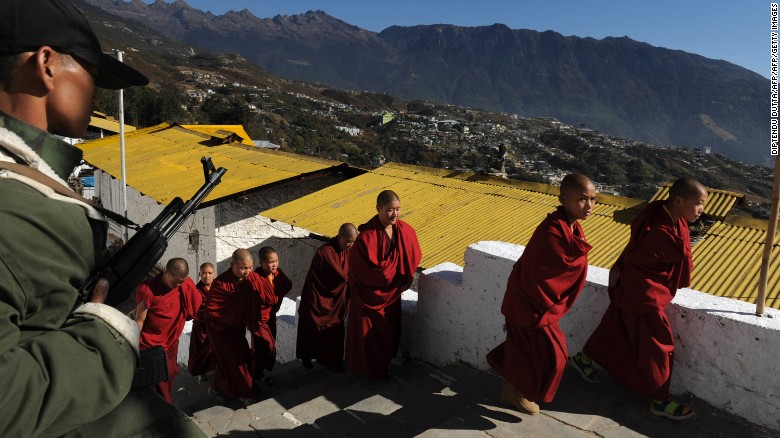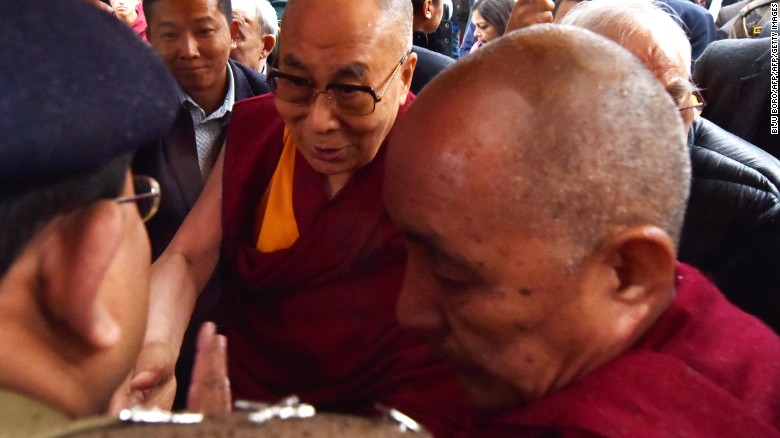Why the Dalai Lama's visit to a tiny town in India is causing such a stir
The Dalai Lama's plans to visit a picturesque Buddhist town in India's northeast have sparked renewed tensions between Beijing and New Delhi.
On Saturday, the 14th Dalai Lama is expected to hold spiritual discussions and impart his teachings in Tawang, a town in the northeastern Indian state of Arunachal Pradesh.
While the religious leader is seen as a thorn in China's side under ordinary circumstances, his visit to Tawang is being seen by Beijing as especially provocative because the town is part of the 84,000 square kilometers of Indian territory that China officially claims as its own.

Indian security personnel stand with a poster of the Dalai Lama as he delivers religious teachings at the Buddha Stadium in Bomdila in India's northeastern state of Arunachal Pradesh state on April 5, 2017.
China's Foreign Ministry warned a Tawang visit would "gravely damage the peace and stability of the border regions between China and India, and China-India relations," adding on Wednesday that by inviting the Dalai Lama to an area where China and India had territorial disputes, the Indian side had "violated its commitment on Tibet-related issues, and escalated the boundary dispute."
In the past, Beijing has called the Dalai Lama a "traitor," branding him "an anti-China separatist under the cloak of religion."
Revered town
Manoj Joshi, a Tibet expert at the Delhi-based think tank Observer Research Foundation, says Tawang is one of the most important places for China when it comes to Tibetan affairs.
The Buddhist town is home to the revered Tawang Monastery, one of the largest outside Tibet's capital Lhasa, and is said to be the birthplace of the popular sixth Dalai Lama, Tsangyang Gyatso.

Monks wearing ceremonial headgear at Tawang Monastery.
In traditional Tibetan belief, the title "Dalai Lama" is for the highest-ranking leader in Tibetan Buddhism. The title is given to those who are the reincarnations of a line of revered religious teachers.
Tawang is strategically important to China because its monastery is one of the hubs of power play in Tibetan internal politics -- and it is the Dalai Lama that appoints the head of this monastery.
China also cares what happens in Tawang because it claims it as its territory.
Proxy battleground
Tawang has history as a proxy battleground between great powers.
In 2016, then US Ambassador to India, Richard Verma, visited the area, sparking a diplomatic kerfuffle. At the time, China said the US would "sabotage the hard-won peace and tranquility in the China-India border areas."
The Dalai Lama's last visit in 2009 also faced strong objections from Beijing.
"Having made one mistake does not give a permit to make another one. It is even more unacceptable to repeat mistakes," China's Foreign Ministry spokesperson Lu Kang said.

A security official, left, stands guard as monks arrive for the last visit by the Dalai Lama to Tawang Monastery in Arunachal Pradesh in November 2009.
Last week, Lu urged India not to give the Dalai Lama "a stage to carry out anti-China and separatist activities, so that we can maintain the healthy and steady growth of China-India relations."
But both the Dalai Lama and India maintain the Tawang trip is purely non-political.
The Indian government has long stressed that Tibetans in India "do not conduct political activities from Indian soil" and doesn't seem to be rattled by the Chinese backlash, with government representatives saying the Dalai Lama is an "honored guest" of the country and that they "have no say in his travels within India."
Small but significant
The hilltop town of Tawang might be tiny, but for the Dalai Lama, the significance of this isolated place remains unparalleled.
Last month marked 58 years of exiled life for the Tibetan leader. The Dalai Lama first entered India in 1959, fearing a Chinese invasion of Tibet.

Indian security personnel walk past Buddhist monks as they wait for the Dalai Lama in Bomdila in India's northeastern state of Arunachal Pradesh on April 4, 2017.
In an emotional reunion on Monday, he met retired Indian soldier Naren Chandra Das, who was part of a group that escorted the Dalai Lama to India from near its border with Tibet during the escape.
He recalled taking "political asylum" in the Tawang area.
"I still feel the feeling of that time," he said on Saturday.
"There was no other way except, you see, escape ... then on the road I was quite tired," the 1989 Nobel Peace Prize winner recalled. "When I reached Khenzimana (India-Tibet border pass), I (was) very happy."
He added that he was very happy to return and "share some of my thoughts with people."
"That is number one. As a Buddhist monk it is my duty, my responsibility to serve, as much as I can, these Buddhists."
News Courtesy: www.cnn.com











